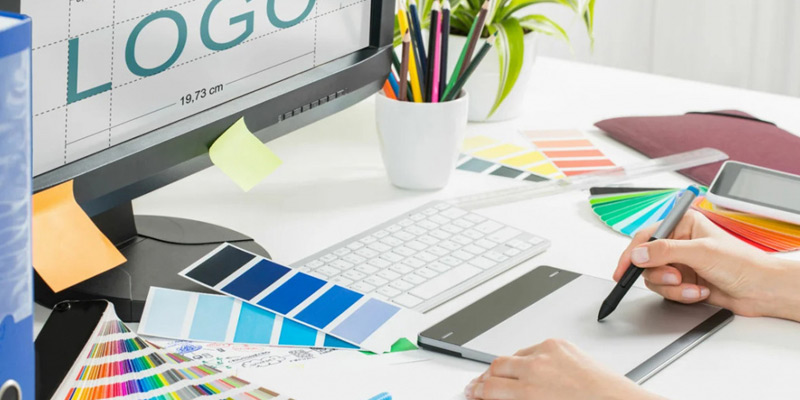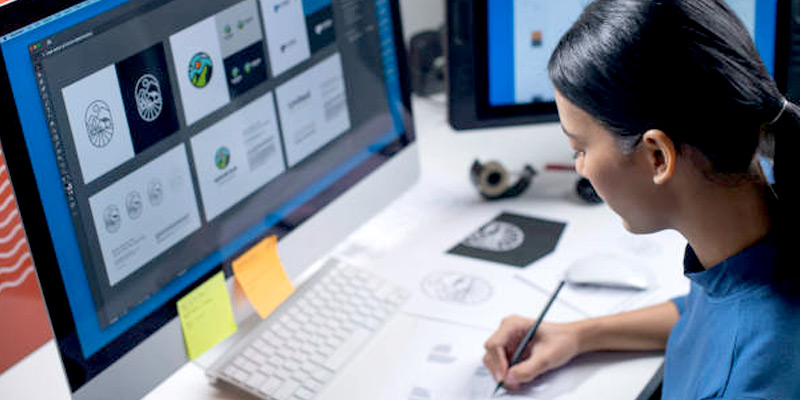Get Upto 60% Discount
Grab 50% Discount
for all custom logos
Please fill the form below & proceed
How Colors, Fonts, and Shapes Influence Customer Behavior in Logo Design

August 11 , 2023 Posted by admin
Learn the psychology underlying logo design’s use of colors, typefaces, shape, and composition so you may use it to create a mark that has a subconscious or psychological impact on customers.
This is so that values that hundreds of written words could only hope to portray might be communicated by an image or a single word.
In actuality, a logo for business and related colors can increase brand recognition by as much as 80%. It is crucial to comprehend the psychology of effective logo design and how it influences consumer behavior.
Making a logo that favorably affects your target audience and communicates the proper emotions and messages can initially seem overwhelming because there are so many different design options.
What exactly should you know in order to use psychology as a creative tool for professional logo design? In order to create unique logos, you must learn how to use the psychology of color, font, shape, and composition. Additionally, you must understand how to affect brand awareness and purchasing habits.
Recognize How Logo Perceptions Are Affected By Colors, Fonts, Shape, and Composition
Color Psychology in Logos

Different colors can convey various ideas and feelings. This is known as color psychology, or the significance of colors. The colors you select for your brand logo will reflect the values of your business, which will also aid in creating brand recognition.
You may make better design choices if you are aware of the subtleties and effects of color on how people view your logo and, consequently, your brand.
For instance, studies at the University of Missouri discovered that the particular colors used in the logo had a substantial impact on how consumers perceive the company’s emblem and the brand as a whole.
Logo Forms’ Psychological Effects

Additionally, custom logo design employs shapes to persuade customers and influence their thoughts and attitudes by effectively communicating certain signals about a business. Consumer research lends credence to the notion that how people perceive your brand’s beliefs, products, and services may depend on the shape of your logo. Logo designers must be aware of the numerous meanings sent by different forms, such as circles, squares, triangles, and vertical and horizontal lines, while creating construction logos or any other type of business logo.
Round Logos
The logos of many of the most well-known companies in the world, including Starbucks, General Electric, and Pepsi, feature circles. This is because they can convey a range of uplifting emotional signals, as well as because their shape is softer and more inviting than the squares and triangles’ sharper angles.
Circles represent stability and strength since they are constant and strong, devoid of breaks or bends. Circles in a logo can give your business a more reliable appearance. Circles connect better with customers because of their associations with marriage and rings, which also relate to commitment and unity.
Target is a well-known business that has a modern logo design. Customers are more likely to recognize the company at first look because of the logo’s usage of two concentric red circles that come together to form a bullseye and reflect the name. However, buyers are also given another crucial message about the brand’s trustworthiness by the Target bullseye emblem. The message is: Come to target, and you’ll find what you’re looking for, or strike the bullseye.
Triangle Motifs
When used as logo shapes, triangles can convey many meanings, such as authority, a sense of hierarchy, motion, or improvement. Adidas, Mitsubishi Motors, and FILA are the only three well-known companies that use triangular logos. Triangles contain energy since they are pushing in a particular direction. Although they might not evoke the same sense of safety and familiarity as rectangles or squares, they can nonetheless help you showcase the creativity and originality of your logo for business.
Consider the Caterpillar logo, which represents the company that makes construction equipment. The company logo is a triangle shape with sharp, distinct edges that exude strength and toughness. Additionally, it has upward-pointing angles to suggest good direction or speed.
Linear Logos
The way lines are shown in a logo might affect how a brand’s audience interprets it. For instance, vertical lines are appealing and subconsciously suggest a sense of power and elegance. They convey expertise and a sense of movement, just as squares and rectangles.
Sound Cloud is one business that makes use of vertical lines in its logo. The logo combines powerful vertical lines with the arcs of a cloud to communicate both strength and inventiveness. The logo of the technology company Cisco likewise features vertical lines to represent boldness, adaptability, and forward-thinking.
Font Psychology in Logos

Some logos have words in addition to their insignia, while others only contain text. Font choices for these logos weren’t picked at random or simply because they were attractive. Instead, the fonts used in a company logo design should indicate a brand’s values and clearly convey the organization’s desired message.
The same is true of font psychology: different hues cause certain individuals to experience various emotions and thoughts.
- Serif Typefaces: Serif typefaces are used in logos by companies like VOGUE and Rolex because they convey a feeling of tradition and legitimacy.
- Sans serif fonts: Sans serif typefaces are used in the logos of Google, Netflix, and Microsoft to symbolize their values of order and friendliness.
- A script font: The elegance of handwriting can be portrayed using a script font. For this reason, script font is perfect for logos like Hallmark’s, a manufacturer of greeting cards.
Last but not least, modern display fonts can have a bold and vibrant tone, making them the perfect option for companies like Disney, SEGA, and Baskin-Robbins.
Psychological Aspects of Composition

Shapes, typefaces, and colors make up the core of a great logo design. However, how those components are combined also impacts how the logo is perceived and what message it sends to customers.
For example, random or uneven arrangement conveys humor, chaos, or rebellion.
Conversely, symmetrical and structured patterns suggest formality, stability, and obedience.
Layered component assembly produces visible relationships. Therefore, logo designers must take into account how shapes and lines interact.
In addition, the size of a logo’s design components determines its priority. The size of a component determines how much attention it draws and how significant it seems.
A great example of how to effectively compose a logo is the National Aeronautics and Space Administration (NASA) logo.
The word NASA is prominently placed in the center of the design in big white letters. Its circular form alludes to a planet, while the stars, the red v-shaped wing, and the orbiting circle around the agency’s name allude to outer space.
As a result of its larger size, NASA stands out the most among these components, even if they are all properly balanced to achieve harmony and balance. The circular orbit intersects the company name to attract focus to the ‘A’ and ‘S,’ further emphasizing ‘Aeronautics’ and ‘Space,’ while the contrasting red color of the V-shape draws attention to what the brand is most known for aeronautics.
Logos Have an Impact on Customer Behavior

All elements of a logo design, such as its colors, typefaces, and forms, are capable of symbolizing concepts and conveying moods to the consumer, as we looked at in the previous section. While it is obvious that a logo influences the consumer, let’s look more closely at how and why this occurs.
Learning about the three psychological principles of symbolism, distinction, and priming can help you comprehend how a logo influences consumers.
Symbolism
Strategic symbols are used by construction logos, to deliver a clear statement. Symbols regularly appear in the collective consciousness.
Consider the heart symbol, which we intuitively understand to symbolize connections and love. Additionally, arrows represent motion and direction, while stars denote fame, patriotism, or religion.
These simplistic shapes that represent abstract symbols convey a fundamental idea. Since symbols have distinct, all-encompassing meanings that cut across cultural and linguistic boundaries, they are commonly used as a visual language. Whether they take the form of particular shapes, visuals, or text, symbols have a significant psychological impact on consumers.
Differentiation
Product differentiation describes marketing strategies that help consumers tell one brand apart from another. This happens when a customer connects an emotional experience with a brand, setting it apart from competitors.
In the end, logos sets a brand apart from its rivals with the intention of giving it emotional worth relative to others.
Consider the airline firms QANTAS and Emirates.
The speed, action, and power associated with flying are all represented by red in both brands’ designs. Still, each company distinguishes itself by incorporating symbols that are connected to its place of origin. While QANTAS’s kangaroo logo designates it as an Australian airline, Emirates’ brand name is written in Arabic calligraphy.
Priming
The brain may be “primed” to anticipate specific things by certain phrases, images, or even sounds. This is how a logo design inspires a specific idea or behavior.
Your mind immediately associates a recognizable garment logo with the previous ideas, emotions, and experiences you’ve experienced with that company. This may affect people’s choices to not only choose a brand once but also to stick with it.
This is further demonstrated by a study done using the Apple logo. After presenting participants with an uncatchable Apple logo, researchers put them through a creative challenge. These participants outperformed those who saw the IBM logo, which is not typically associated with creativity.
Apple had just ended a great campaign with dozens of creative people and the slogan “Think Different” at the time of the testing. Thanks in part to this marketing, the Apple name has come to represent the idea of innovation.
Test respondents were predisposed to think more imaginatively after seeing that logo design.
Conclusion
The success of a logo is ultimately defined by how viewers react to it, as well as the quality of the logo design. If a logo is to have any psychological or subconscious effect on the customer, it needs to be relevant, meaningful, and aimed at the appropriate audience. Understanding the psychology of color, font, shape, and composition will help you create a unique logo that tells much about your company. However, if you are looking for construction logos or garment logos, then contact Logo Magicians.

Leave a Reply